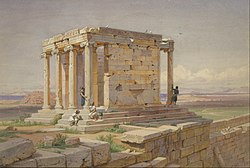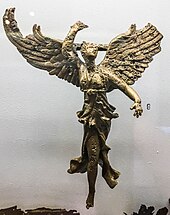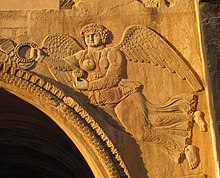
The Temple of Athena Nike (Greek: Ναός Αθηνάς Νίκης, Naós Athinás Níkis) is a temple on the Acropolis of Athens, dedicated to the goddesses Athena and Nike. Built around 420 BC, the temple is the earliest fully Ionic temple on the Acropolis. It has a prominent position on a steep bastion at the south west corner of the Acropolis to the right of the entrance, the Propylaea. In contrast to the Acropolis proper, a walled sanctuary entered through the Propylaea, the Victory Sanctuary was open, entered from the Propylaea's southwest wing and from a narrow stair on the north. The sheer walls of its bastion were protected on the north, west, and south by the Nike Parapet, named for its frieze of Nikai celebrating victory and sacrificing to their patroness, Athena and Nike.
Nike was the goddess of victory in Greek mythology, and Athena was worshipped in this form, representative of being victorious in war. The citizens worshipped the goddesses in hopes of a successful outcome in the long Peloponnesian War fought against the Spartans and allies.
History
In the sixth century BCE a cult of Athena Nike was established and a small temple was built using Mycenaean fortification and Cyclopean masonry. After the temple was demolished by the Persians in 480 BCE a new temple was built over the remains. The new temple construction was underway in 449 BCE and was finished around 420 BCE. The cult was supervised by the Priestess of Athena Nike, who was appointed through democratic allotment.[1] If still in use by the 4th-century, the temple would have been closed during the persecution of pagans in the late Roman Empire.
The temple sat untouched until it was demolished in 1686 by the Turks who used the stones to build defenses. In 1834 the temple was reconstructed after the independence of Greece. In 1998 the temple was dismantled so that the crumbling concrete floor could be replaced and its frieze was removed and placed in the new Acropolis Museum that opened in 2009.[2] The Temple of Athena Nike is often closed to visitors as work continues. The new museum exhibit consists of fragments of the site before the Persians were thought to have destroyed it in 480 BCE. Sculptures from the friezes have been salvaged such as: deeds of Hercules, statue of Moscophoros, a damaged sculpture of a goddess credited to Praxiteles and the Rampin horseman, as well as epigraphic dedications, decrees, and stelae.[3]
Architecture
The Temple of Athena Nike was finished around 420 BC,[4] during the Peace of Nicias. It is a tetrastyle (four column) Ionic structure with a colonnaded portico at both front and rear facades (amphiprostyle), designed by the architect Kallikrates. The columns along the east and west fronts were monolithic columns. The temple ran 8 metres (27 ft) long by 5.5 metres (18.5 ft) wide and 7 metres (23 ft) tall. The total height from the stylobate to the acme of the pediment while the temple remained intact was a modest 7 metres (23 ft). The ratio of height to diameter of the columns is 7:1, rather than the more standard 9:1 or 10:1 ratio in Ionic buildings. Constructed from white Pentelic marble, it was built in stages as war-starved funding allowed.
Cult statue and frieze
The famous frieze of Nike adjusting her sandal is an example of Wet drapery.[5] Wet drapery involves showing the form of the body but also concealing the body with the drapery of the clothing. Some friezes are from the Persian and Peloponnesian wars. The friezes contained a cavalry scene from the battle of Marathon and a Greek victory over the Persians at the battle of Plataea. The battles represent Greek and Athenian dominance through military power and historical events.[6] A statue of Nike stood in the cella, or otherwise referred to as a naos. Nike was originally the "winged victory" goddess (see the winged Nike of Samothrace). The Athena Nike statue's absence of wings led Athenians in later centuries to call it Apteros Nike or wingless victory, and the story arose that the statue was deprived of wings so that it could never leave the city.
The friezes of the building's entablature were decorated on all sides with relief sculpture in the idealized classical style of the 5th century BC. The north frieze depicted a battle between Greeks entailing cavalry. The south frieze showed the decisive victory over the Persians at the battle of Plataea. The east frieze showed an assembly of the gods Athena, Zeus and Poseidon, rendering Athenian religious beliefs and reverence for the gods bound up in the social and political climate of 5th Century Athens.
Some time after the temple was completed, around 410 BC a parapet was added around it to prevent people from falling from the steep bastion. The outside of the parapet was adorned by carved relief sculptures showing Nike in a variety of activities and all in procession.[7]
Architects Christian Hansen and Eduard Schaubert excavated the temple in the 1830s. The building had been totally dismantled in the 17th century and the stone built into the Turkish wall that surrounded the hill. A primitive anastylosis was carried out in 1836 when the temple was re-erected from remaining parts. A third restoration was completed in Summer 2010.[8] The main structure, stylobate and columns are largely intact, minus the roof and most of the tympanae. Fragments of the sculpted frieze are exhibited in the Acropolis Museum and the British Museum; copies of these are fixed in their place on the temple.
Akroteria
The main body of the statue that made up the Akroteria was composed of bronze (not marble). There is evidence of gold foiling and gold wiring through the main bronze core. Although there has been a hypothesis on the form of the statue, there is no trace of the original sculpture to be certain of what the Akroteria really looked likeAthena
Ἀθηνᾶ
Goddess of wisdom, olives, weaving, and battle strategy | |
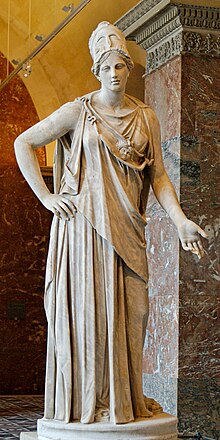 Mattei Athena at Louvre. Roman copy from the 1st century BC/AD after a Greek original of the 4th century BC, attributed to Cephisodotos or Euphranor. | |
| Abode | Mount Olympus |
| Symbol | Owls, olive trees, snakes, Aegis, armour, helmets, spears, Gorgoneion |
| Personal information | |
| Parents | In the Iliad: Zeus alone In Theogony: Zeus and Metis[a] |
| Siblings | Aeacus, Angelos, Aphrodite, Apollo, Ares, Artemis, Dionysus, Eileithyia, Enyo, Eris, Ersa, Hebe, Helen of Troy, Hephaestus, Heracles, Hermes, Minos, Pandia, Persephone, Perseus, Rhadamanthus, the Graces, the Horae, the Litae, the Muses, the Moirai |
| Children | No natural children, but Erichthonius of Athens was her adoptive son |
| Equivalents | |
| Roman equivalent | Minerva |
| Etruscan equivalent | Menrva |
| Canaanite equivalent | Anat[2] |
| Egyptian equivalent | Neith |
| Celtic equivalent | Sulis |
Athena[b] or Athene,[c] often given the epithet Pallas,[d] is an ancient Greek goddess associated with wisdom, handicraft, and warfare[3] who was later syncretized with the Roman goddess Minerva.[4] Athena was regarded as the patron and protectress of various cities across Greece, particularly the city of Athens, from which she most likely received her name.[5] She's usually shown in art wearing a helmet and holding a spear. Her major symbols include owls, olive trees, snakes, and the Gorgoneion.
From her origin as an Aegean palace goddess, Athena was closely associated with the city. She was known as Polias and Poliouchos (both derived from polis, meaning "city-state"), and her temples were usually located atop the fortified acropolis in the central part of the city. The Parthenon on the Athenian Acropolis is dedicated to her, along with numerous other temples and monuments. As the patron of craft and weaving, Athena was known as Ergane. She's also a warrior goddess, and was believed to lead soldiers into battle as Athena Promachos. Her main festival in Athens was the Panathenaia, which was celebrated during the month of Hekatombaion in midsummer and was the most important festival on the Athenian calendar.
In Greek mythology, Athena was believed to have been born from the head of her father Zeus. In the founding myth of Athens, Athena bested Poseidon in a competition over patronage of the city by creating the first olive tree. She's known as Athena Parthenos "Athena the Virgin," but in one archaic Attic myth, the god Hephaestus tried and failed to rape her, resulting in Gaia giving birth to Erichthonius, an important Athenian founding hero. Athena was the patron goddess of heroic endeavor; she was believed to have aided the heroes Perseus, Heracles, Bellerophon, and Jason. Along with Aphrodite and Hera, Athena was one of the three goddesses whose feud resulted in the beginning of the Trojan War.
She plays an active role in the Iliad, in which she assists the Achaeans and, in the Odyssey, she is the divine counselor to Odysseus. In the later writings of the Roman poet Ovid, Athena was said to have competed against the mortal Arachne in a weaving competition, afterwards transforming Arachne into the first spider; Ovid also describes how she transformed Medusa into a Gorgon after witnessing her being raped by Poseidon in her temple. Since the Renaissance, Athena has become an international symbol of wisdom, the arts, and classical learning. Western artists and allegorists have often used Athena as a symbol of freedom and democracy.
Goddess of victory | |
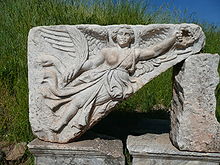 Stone carving of the goddess Nike at the ruins of the ancient city of Ephesus | |
| Abode | Mount Olympus |
| Symbol | golden sandals, wings, wreaths |
| Personal information | |
| Parents | Pallas and Styx |
| Siblings | Kratos, Bia, Zelus and Scylla, Fontes (Fountains), Lacus (Lakes) |
| Roman equivalent | Victoria |
| Part of a series on |
| Ancient Greek religion |
|---|
 |
|
|
|
|
|
|
|
|
|
|
|
|
|
|
|
|
|
|
In ancient Greek civilization, Nike (/ˈnaɪki/; Ancient Greek: Νίκη, lit. 'victory', ancient: [nǐː.kɛː], modern: [ˈni.ci]) was a goddess who personified victory.[1] Her Roman equivalent was Victoria.
Etymology
The Greek word νίκη (nikē) is of uncertain etymology. R. S. P. Beekes has suggested a Pre-Greek origin.[2] Others have connected it to Proto-Indo-European *neik- (“to attack, start vehemently”) making it cognate with Ancient Greek: νεῖκος (neîkos, "strife") and Lithuanian: ap-ni̇̀kti ("to attack").[3]
| Greek deities series |
|---|
| Personified concepts |
|
|
List |
Family
Nike is the daughter of the Titan Pallas and the goddess Styx, and the sister of Kratos (Strength), Bia (Force), and Zelus (Zeal).[4]
And Styx the daughter of Ocean was joined to Pallas and bore Zelus (Emulation) and trim-ankled Nike (Victory) in the house. Also she brought forth Kratos (Strength) and Bia (Force), wonderful children.
In other sources, Nike was described as the daughter of Ares, the god of war.[5]
Ares [...]. O defence of Olympus, father of warlike Victory (Nike).
Mythology
Nike and her siblings were close companions of Zeus, the dominant deity of the Greek pantheon. According to classical (later) myth, Styx brought them to Zeus when the god was assembling allies for the Titanomachy against the older deities. Nike assumed the role of the divine charioteer for him and Athena, a role in which she often is portrayed in Classical Greek art. Nike flew around battlefields rewarding the victors with glory and fame, symbolized by a wreath of laurel leaves (bay leaves).
Cult
Sculptures of Nike were extremely common in Ancient Greece and used both in secular public spaces of many categories as well as in the temples of other gods. She was often seen as a miniature sculpture in the hand of Athena and Zeus. Nike was also depicted with famous athletes, symbolizing their victories. In public places as well as temples, she was depicted in sculpture to commemorate victories in war and competitions.
While Nike was often depicted in sculpture and often included in the cults of other gods, particularly Zeus and Athena, only a few sanctuaries dedicated solely to her are mentioned. Pausanias noted that there was an altar solely to Nike in Olympia close to the altar of Zeus Purifier,[6] and he also noted the temple of Nike in Athens: "On the right of the gateway [of the Akropolis (Acropolis) in Athens] is a temple of Nike Apteron (Wingless)."[7]
Depiction
Nike is seen with wings in most statues and paintings, with one of the most famous being the Winged Victory of Samothrace in the Louvre. Most other winged deities in the Greek pantheon had shed their wings by Classical times. Nike was a very close acquaintance of Athena, and is thought to have stood in Athena's outstretched hand in the statue of Athena located in the Parthenon.[8] Nike is also one of the most commonly portrayed figures on Greek coins.[9] After victory at the Battle of Marathon, Athenians erected the Nike of Callimachus.[10]
Names stemming from Nike include among others: Nikolaos, Nicholas, Nicola, Nick, Nicolai, Niccolò, Nikolai, Nicolae, Nils, Klaas, Nicole, Ike, Niki, Nikita, Nikitas, Nika, Nieke, Naike, Niketas, Nikki, Nico, and Veronica.[citation needed]
Contemporary usage
- The sports equipment company Nike, Inc., is named after the goddess Nike.[11] The Nike company's primary product is shoes. The goddess Nike is usually depicted as barefoot and/or winged.
- Project Nike, an American anti-aircraft missile system, is named after the goddess Nike.[12]: 3
- Since Giuseppe Cassioli's design for the 1928 Summer Olympics, the obverse face of every Olympic medal bears Nike's figure holding a palm frond in her right hand and a winner's laurel crown in her left.[13][14]
- The Honda motorcycle company's wing logo was inspired by the goddess Nike.[15]
- The 1988 U.S. Commemorative $5 Gold Coin (commemorating the 1988 Summer Olympics in Seoul, South Korea) has a depiction of Nike on the obverse by engraver Elizabeth Jones

